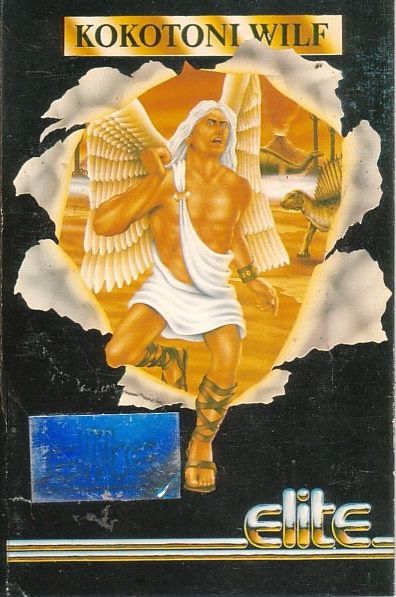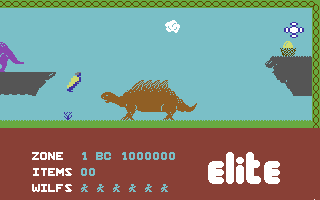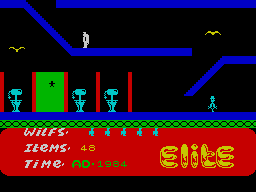Retro Replay Review
Gameplay
Kokotoni Wilf offers a refreshing take on the classic platformer by placing you in control of a time-hopping hero equipped not with brute force, but with the delicate art of flight and hover precision. Unlike traditional jump-and-run titles where you dodge or dispatch enemies, here your sole defense is agility—you must navigate hazards ranging from prehistoric dinosaurs to futuristic spaceships purely by skillful evasion. This elevates every movement into a high-wire act, turning each screen into a carefully choreographed dance of timing and spatial awareness.
(HEY YOU!! We hope you enjoy! We try not to run ads. So basically, this is a very expensive hobby running this site. Please consider joining us for updates, forums, and more. Network w/ us to make some cash or friends while retro gaming, and you can win some free retro games for posting. Okay, carry on 👍)
The game unfolds across 63 interconnected screens divided into six distinct time zones, each with its own palette of challenges and environmental quirks. Early access to the first three screens of every world gives you a taste of what’s to come, but soon you’ll discover that more than two exits per screen create a sprawling, maze-like experience. Some paths lead to safety, while others deposit you directly into hazard zones or dead ends, forcing you to plan your route with foresight rather than brute persistence.
Collecting the seven star-like pieces of the Dragon Amulet requires thorough exploration and repeated visits to earlier screens, rewarding players who pay attention to subtle visual cues and platform layouts. Without any weaponry to rely on, progression boils down to memorizing enemy patterns, mastering mid-air adjustments, and learning the exact hover points needed to reach hidden nooks. This level of challenge may seem daunting, but it also ensures a deeply satisfying sense of accomplishment when you finally claim another amulet fragment.
Graphics
For a game released in the mid-1980s, Kokotoni Wilf’s visual presentation is surprisingly polished. The side-view screens brim with colorful, well-defined sprites that bring each time zone to life, from lush prehistoric jungles to neon-lit space stations. While the palette is limited by the hardware of the era, the developers made clever use of contrasting hues to highlight platforms, hazards, and collectible items, ensuring you always know precisely where to guide your hovering hero.
Backgrounds are simple yet effective, with parallax-like scrolling in certain levels adding depth to the 2D environment. Small details—like the flicker of a spear trap or the blinking lights of an alien craft—imbue each frame with character and atmosphere. Although the animation runs at a modest frame rate, Wilf’s fluttering wings and graceful hover mechanics feel fluid enough to convey the responsiveness you need to tackle the game’s tight quarters and precision jumps.
The visual design also shines in its variety. Each time zone exhibits its own style and palette shifts that keep the experience from growing stale as you work through dozens of screens. From earthen browns and greens in prehistoric stages to cold metallic grays and vibrant purples in futuristic settings, the graphical choices help you immediately recognize where you are—an essential touch in a game that thrives on exploration and navigation.
Story
The narrative premise of Kokotoni Wilf is refreshingly straightforward: you are Wilf, entrusted by the Dragon King to recover the seven dispersed fragments of the Dragon Amulet across time itself. This simple framework provides a clear objective and a strong thematic backbone for your inter-era travels, uniting diverse levels under a single quest. There’s no overwrought lore or lengthy cutscenes—just an elegant, almost mythic mission that gives context to every leap, glide, and narrow escape.
Despite the concise storyline, the sense of scale is impressive. You’re not merely collecting arbitrary items: each star-like amulet piece represents a portion of a mighty relic whose power threatens to fall into the wrong hands. This injects your exploration with urgency and purpose, making each recovered fragment feel like a meaningful victory rather than just another generic token. The time-travel element further spices up the tale, as you get the chance to witness and outmaneuver foes from multiple eras.
Moreover, the minimalistic storytelling complements the gameplay rather than overshadowing it. With no inventory screens or dialog trees to interrupt the action, the narrative flows seamlessly through level design. Environmental storytelling—such as the remnants of ancient temples or malfunctioning machinery in a space station—hints at a broader world history, letting your imagination fill in the gaps while you focus on mastering Wilf’s aerial acrobatics.
Overall Experience
Kokotoni Wilf stands out as a classic platformer that balances accessibility with depth. On first playthrough, the novelty of unlimited flight combined with precision hovering immediately sets it apart from contemporaries like Jet Set Willy. But as you delve deeper, the game reveals layers of complexity: dead-end exits, hidden pathways, and cleverly placed hazards all conspire to keep you on your toes. This ensures a rewarding learning curve that veteran gamers will appreciate.
The absence of an in-game weapon forces you to develop a deep understanding of level layouts and enemy movements. Such design might frustrate newcomers at first, but it also promotes experimentation and mastery. Save points are infrequent, so each mistake stings—and each successful traversal, no matter how short, feels triumphant. This tension between risk and reward is the beating heart of the Kokotoni Wilf experience.
Ultimately, Kokotoni Wilf is a voyage worth undertaking for fans of retro platformers and precision-based challenges. Its timeless art style, tight controls, and clever level design combine into an adventure that still resonates decades after its original release. Whether you’re collecting your first amulet shard or hunting down the final piece, every moment in Kokotoni Wilf underscores the joy of discovery, mastery, and, above all, the thrill of flight.
 Retro Replay Retro Replay gaming reviews, news, emulation, geek stuff and more!
Retro Replay Retro Replay gaming reviews, news, emulation, geek stuff and more!









Reviews
There are no reviews yet.